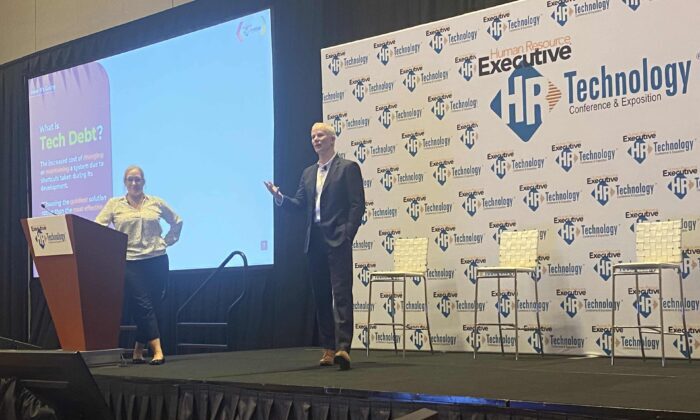Consumers love their apps: About 175 billion apps are downloaded each year, with the average phone having 80 apps on it. And how many of those phone users keep up with the fine print of the update notices and legal terms?
Pretty much no one, said Mark Stelzner and Kimberly Carroll of consulting firm IA at a Wednesday mega session at the HR Technology Conference in Las Vegas.
Overinvestment in—and inattention to—apps is not just a consumer problem: The average organization deploys 371 SaaS apps—a number that stands at 473 for large enterprises, up from 317 just two years ago.
However, more than half of SaaS licenses are unused, the tech is largely ungoverned and most function on a one-year contract—with organizations not doing the work to decommission it after such time, Stelzner says.
That is leading more than three-quarters of IT professionals to worry about security risks from this “SaaS sprawl.”
Carroll cited an IA client: a large, global multinational that operates 130 brands in 96 countries. It was bringing on a new HCM with the intent of decommissioning over 300 older systems. The company rolled out what it deemed the “perfect platform,” yet it implemented only 10% of its features—and only 40% of employees had access to it. Plus, it didn’t actually decommission any of its older systems—and added 14 more.
“Clients think the issue is the technology itself,” Carroll says, “but they’re only using a fractional proportion [of the system]. They’ve never seen the real value of the technology.”
And just like with consumer apps, updates are frequent—Stelzner estimates there are 15-20 updates per year for each of the couple dozen HR apps the average organization has—creating further functionality and integration complications.
Ultimately, these challenges fuel high levels of organizational “tech debt,” which Stelzner and Carroll define as the “increased cost of changing or maintaining a system due to shortcuts taken during its development.” In particular, HR tech debt drives “untapped value and unrealized returns.”
So, how can organizations tackle this debt? Just like in the consumer world, tracking their “HR Tech Credit Score,” Carroll and Stelzner suggest, can help business leaders make smarter HR tech investment decisions.
4 keys to the tech strategy
That approach requires a four-pronged tech investment strategy, with equal attention given to each area:
- Engagement: Tools should be simple and personalized to meet employees where they are. Think mobile-first, multi-lingual and enhanced by AI.
- Integration: This goes hand in hand with engagement. “We have to have our tools and technology link and integrate in a way that’s available, consumable, personalized and accessible,” Stelzner says.
- Process: “Process-led, tech-enabled” is the name of the game if employers want to capture the ROI of their tech investments, they say. This involves defining global process owners and creating prioritization plans—which can ultimately uncover and eliminate wastes of time and money. IA, for instance, once led a client to find $1.8 million in savings by identifying pain points in its complex, manual onboarding process.
- Governance: To make the most of tech investments, leadership needs to be diligent about governing the systems, the integrations and the changes that come to them, Carroll says.
Ultimately, leaders who consider their tech investments through this four-part lens can bring greater accountability, transparency, participation and agility to their organizations’ technology strategies.
It’s not always an easy lift for HR leaders to get the C-suite on board with a retooled tech strategy, however, Stelzner notes. Yet, HR is “firmly in the middle of every conversation happening related to the business” today, he says—and needs to take advantage of that position.
Be both “interested” and “interesting,” Stelzner says, to get the tech strategy the attention it needs.
“Study your business—and I mean study your business: the financials, the M&A strategy, C-suite turnover. Be hungry to consume everything the organization is putting out,” he says. “Then have something to say about it.”
Credit: Source link












